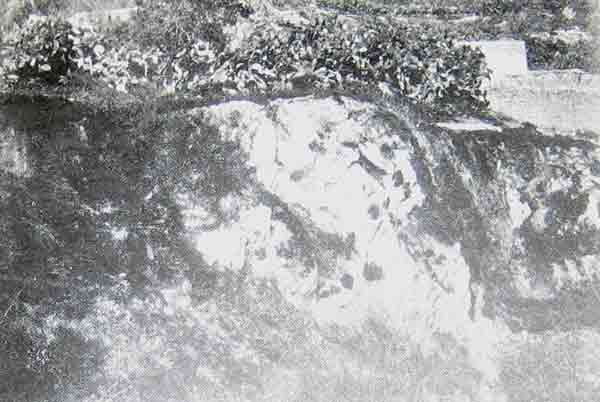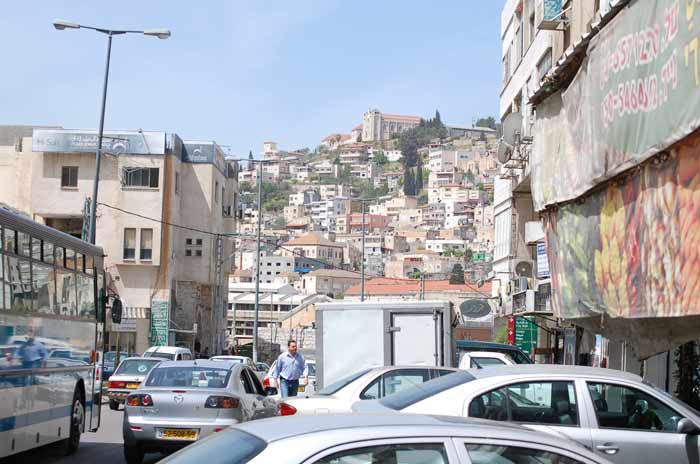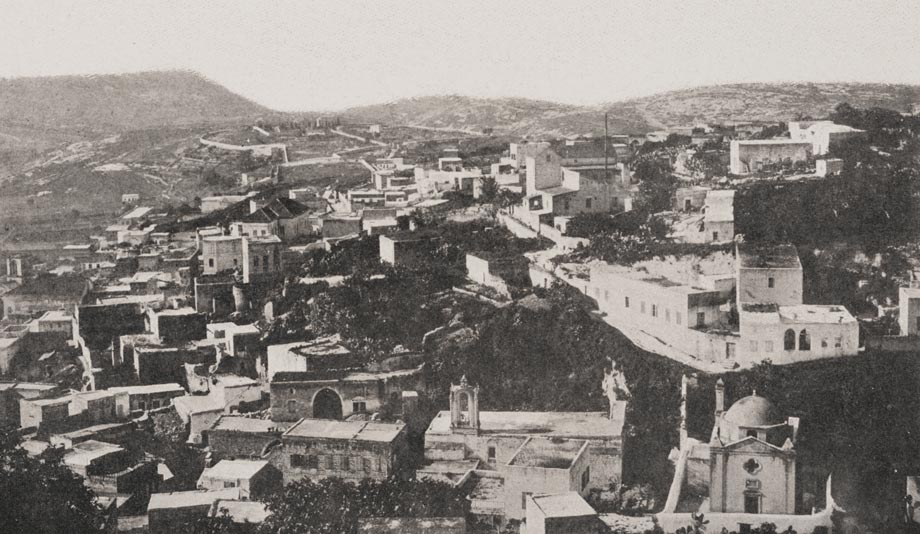
ISRAEL PHOTOS IV -- Pilgrimage |
Jesus in the Synagogue of Nazareth
An early pilgrim wrote an imagined account of Jesus preaching in the synagogue of Nazareth based on his knowledge of the Jewish worship service, and the Gospel According to Luke:
"Picture then the Saviour as He sits there on the most momentous day of His life. The service began quietly, the Psalms of David were sung, as I have said, the Scripture read by the chief elder and its translation given by the Meturgeman, and the elder had commented on it, wisely or unwisely, as the case might be. Then another portion of Scripture had to be read, and our Lord stood up to read it. There was handed to Him the Roll of the Prophet Isaiah. The Chazzan opened the Ark, took out the Roll and brought it to Christ at the lower end of the Synagogue. ...He at last put it into the hands of our Lord: so far all was in order." With Christ in Palestine, Schofield, 1906
Luke 4:17-30 (WEB)
17 The book of the prophet Isaiah was handed to him. He opened the book, and found the place where it was written, 18 “The Spirit of the Lord is on me,
because he has anointed me to preach good news to the poor. He has sent me to heal the broken hearted, to proclaim release to the captives,
recovering of sight to the blind, to deliver those who are crushed, 19 and to proclaim the acceptable year of the Lord.” 20 He closed the book, gave it
back to the attendant, and sat down. The eyes of all in the synagogue were fastened on him. 21 He began to tell them, “Today, this Scripture has been
fulfilled in your hearing.” 22 All testified about him, and wondered at the gracious words which proceeded out of his mouth, and they said,
“Isn’t this Joseph’s son?” 23 He said to them, “Doubtless you will tell me this parable, ‘Physician, heal yourself! Whatever we have heard done at
Capernaum, do also here in your hometown.’” 24 He said, “Most certainly I tell you, no prophet is acceptable in his hometown. 25 But truly I tell you,
there were many widows in Israel in the days of Elijah, when the sky was shut up three years and six months, when a great famine came over all the land.
26 Elijah was sent to none of them, except to Zarephath, in the land of Sidon, to a woman who was a widow. 27 There were many lepers in Israel in the time
of Elisha the prophet, yet not one of them was cleansed, except Naaman, the Syrian.” 28 They were all filled with wrath in the synagogue, as they heard
these things. 29 They rose up, threw him out of the city, and led him to the brow of the hill that their city was built on, that they might throw him
off the cliff. 30 But he, passing through the middle of them, went his way.
As to whether or not the Jews of Jesus' day could have been enraged enough to try to kill Jesus for alleged blasphemy on the Sabbath, there have been reports for years of Orthodox Jews stoning cars on the Sabbath, for they do not want anyone to drive during the Sabbath. The rage against those violating the religious laws was greater than the command not to carry stones on the Sabbath. Since Maccabean times it has been legal for Israel to go to war during the Sabbath, but not to work during Sabbath. Orthodox Jews threw stones at archaeologists excavating the tomb of the Roman era high priest Caiphas due to their religious laws about corpse uncleanness or some other supposition. More recently there was an Israeli national law passed forbidding the excavation of Jewish tombs as the Orthodox do not want these remains disturbed. In a different incident the Orthodox people (Haredim) were throwing stones during a protest against showing movies during the Sabbath. While it is legal to drive in Israel during the Sabbath, most Jews do not drive during the Sabbath/Shabaht, and some streets were blocked off during the Sabbath to make Orthodox neighborhoods quiet and peaceful. There was traffic on the roads during Shabaht, but not is some districts. One year I was on my way to the airport during Shabaht and had taken a wrong turn into a religious neighborhood. A police officer pulled me over and warned me not to drive in this Jewish neighborhood during the Sabbath. National parks and museums were open during Sabbath. Most shops and businesses were closed on Shabaht. The Ministry of Labor worked to make the seventh day a day of rest for most Jewish Israelis.
If Jesus enraged the synagogue congregation with his preaching during the Sabbath, they may also have waited till sundown or the morning of the next day to confront him. Many Jewish people do not accept Jesus as Messiah.
Attempts by Christians to convert Jews to Christianity in Israel have been discouraged by force of law. Christians have been excluded from Jewish communities and workplaces. By its charter Israel is for Jewish immigrants. After the Nazi persecutions many Jewish Israelis do not trust outsiders. It is against the law to try to convert Israeli Jews to Christianity. This law also forbids handing out Christian literature to Jews. In 2013 tourists convicted under this statute were jailed and processed for deportation In 2012 Christian leadership began to encourage Christians to enlist in the IDF as Israel was less discriminatory towards Christians than Middle Eastern Muslim nations. Christian Arabs want an ethnic identity separate from Muslim Arabs.
An alternate description in the Gospel According to Mark:
In the 1920's there was a missionary hospital in Nazareth and a pilgrim reported: "In a single year as many as a hundred and fifty operations are performed by the eye department." Sight was yet being given to the blind by those who had benefited from Jesus' instructions and sought to do good works as well. The Merchant of the Muristan, Miller, 1927.
In addition to the large cliffs on the SW outskirts of town reported in Israel Photos III; there was a cliff reported behind the Maronite Church in Nazareth not far from the spring now called the well of Mary. The Roman era town must have been built near the spring where the town drew its water from. The synagogue may have been close to the center of town. The modern city of Nazareth is much larger than the village early pilgrims visited.

View of one several precipices reported at Nazareth, 1903, W. Sanday:
Plate XXIII B. There are no less than four so-called Cliffs of Precipitation (referring to the incident of St. Luke iv. 29): one in the hands
of the Latins, one in the hands of the Greeks, one some way out of Nazareth ...and the one in this plate, which is not only more probable than the rest,
but in itself really probable, as it lies just at the back of ancient Nazareth.
There are other written accounts of cliffs in Nazareth from 30-60
feet high.

Houses clinging to the hill side above the Mary's Well neighborhood.
Descriptions of a precipice within the town limits:
In Christ’s Own Country, Francis Clark, NY, 1914:
On the west side of the town, behind the Maronite church, is a long, steep cliff, or series of cliffs, now covered with abundant rubbish which the centuries have accumulated, out of which might once have been fifty or sixty feet high. Dean Stanley thinks that this may have been the “brow of the hill” whereon the city was built, and that here, after the sermon in the synagogue, before alluded to, where He told them that no prophet was acceptable in His own country, the people rose up in their wrath to throw Him down headlong. Others however, place the “Hill of Precipitation,” at a considerably greater distance from the city.
From Egypt to Palestine, by S.C. Bartlett, NY, 1879
"...After a long and delightful view of this attractive scene, on the way down the mountain we looked for some precipice that might have answered the design of the Saviour’s townsmen to hurl him down headlong. We were unsuccessful at the time, although the next day, by the aid of Mr. Zeller, the excellent missionary, with whose family we spent a delightful evening, we found in the rear of the Maronite church the precipice, still forty or fifty feet high, which Robinson, Tobler, Hackett, and others well regard as perhaps more probable than any other. The Traditional Mount of Precipitation is two miles from the town, and from the fountain which must always have determined the site of the town. An anger so hot as to attempt his violent death, and so cool as to travel two miles for a good place for the assassination, may not tax the credulity of a monk, but is difficult for an Anglo-Saxon to accept."
Those Holy Fields, Palestine, Rev. Samuel Manning, London, 1875
A hasty and general survey of the site of Nazareth produces the impression that it contains no cliff down which Jesus could have been “cast headlong.” The town lying along the lower slope of the hill, no steep declivity is visible. But a more careful examination corrects the error and confirms the narrative of the evangelist.I found two or three precipitous walls of rock thirty or forty feet in depth. One of them had a considerable accumulation of debris at the bottom, which if cleared away would probably give twenty more. Dean Stanley’s remarks are well worth quoting. “‘They rose’ it is said of the infuriated inhabitants of the city, ‘and cast Him out of the city, and brought him to the brow of a mountain on which the city was built, so as to cast him down the cliff.’ Most readers probably imagine a town built on the summit of a mountain, from which summit the intended precipitation was to take place. This, as I have said, is not the situation of Nazareth, yet its position is in strict accordance with the narrative. It is built upon, that is on the side of ‘a mountain,’ but the brow is not beneath but over the town, and such a cliff as is here implied is to be found in the abrupt face of the limestone rock, about thirty or forty feet high, overhanging the Maronite convent at the south-west extremity of the town.”

The church with the round dome in the lower right of photo is the Mensa Christi Church, the church to the left of it with a square belfry is the Maronite Church. There was a series of cliffs behind it more apparent to earlier travelers as the area is more densely built in modern times.
For more information about the cliff behind the Maronite Church see:; https://dqhall59.com/israelphotosV/maronite_church_cliff.htm
There is a traditional site called the 'Mt. of Precipice' about two miles from Nazareth; where early Christians marked the site of the angry mob attempting to execute Jesus: https://dqhall59.com/Mt_of_Precipice.htm
David Q. Hall
dqhall59@yahoo.com
Nazareth Synagogue
Churches of the Annunciation
Latin Tradition -- Mount of Precipitation
Nazareth Aerial View
Museum of the Basilica
Hot Springs at Tiberias
Stone Water Jars at Capernaum
Capernaum
Tabgha
Bethsaida
A 1909 Galilee Fishing Description
The Giant Mustard Plant
Kursi and the Gadarene Demoniac
Jar of Ointment
Cana
Wheat and Tares